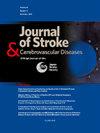Tryptophan metabolites as biomarkers to predict the severity and prognosis of acute ischemic stroke patients
IF 1.8
4区 医学
Q3 NEUROSCIENCES
Journal of Stroke & Cerebrovascular Diseases
Pub Date : 2025-06-17
DOI:10.1016/j.jstrokecerebrovasdis.2025.108382
引用次数: 0
Abstract
Objective
Ischemic stroke is among the leading causes of mortality and long-term disability worldwide. A growing body of evidence indicates alterations in metabolite levels and enzyme activities associated with the conversion of tryptophan (TRP) throughout the course of cerebral ischemia. In this study we aim to explore the potential relationship between TRP metabolism and clinical prognosis in acute ischemic stroke (AIS) patients of mainland China.
Materials and methods
Blood samples were obtained from a cohort of 304 patients diagnosed with AIS. The concentrations of ten TRP metabolites were quantified utilizing liquid chromatography-tandem mass spectrometry (LC-MS/MS). Stroke severity was evaluated upon admission using the National Institutes of Health Stroke Scale (NIHSS). A poor functional outcome was defined as a modified Rankin scale (mRS) > 3, whereas a good functional outcome was defined by mRS ≤ 3 at 3 months post-stroke. LASSO regression and random forest algorithms were then employed to identify key TRP metabolism parameters associated with prognosis.
Results
Following the optimization of variable selection through Lasso regression, a prognostic risk model with 7-factors related to AIS was constructed, yielding an AUC of 0.917. Subsequently, a random forest analysis was conducted to establish an 11-factor prognostic risk model, which demonstrated an enhanced AUC of 1.000. Ultimately, three robust parameters related to TRP metabolism were identified. Multivariable logistic regression analysis, adjusted for covariates, revealed that TRP (odds ratio .[OR] = 0.46, 95 % confidence interval .[CI]: 0.26 - 0.76, p = 0.004), the kynurenine (KYN)/TRP ratio (OR = 2.06, 95 % CI: 1.23 - 3.60, p = 0.008), and the kynurenic acid (KYNA)/TRP ratio (OR = 2.15, 95 % CI: 1.23 - 4.12, p = 0.014) were independently associated with poor functional prognosis.
Conclusions
The results of this study indicate that TRP metabolism is associated with the severity and prognosis of AIS. The TRP, KYN/TRP ratio and KYNA/TRP ratio may serve as potential biomarkers for 3-month prognostic evaluation.
色氨酸代谢物作为预测急性缺血性脑卒中患者严重程度和预后的生物标志物
目的缺血性中风是世界范围内导致死亡和长期残疾的主要原因之一。越来越多的证据表明,在整个脑缺血过程中,与色氨酸(TRP)转化相关的代谢物水平和酶活性发生了变化。本研究旨在探讨中国大陆急性缺血性脑卒中(AIS)患者TRP代谢与临床预后的潜在关系。材料和方法从304例诊断为AIS的患者中采集血液样本。采用液相色谱-串联质谱(LC-MS/MS)对10种色氨酸代谢物的浓度进行定量分析。入院时使用美国国立卫生研究院卒中量表(NIHSS)评估卒中严重程度。功能预后差定义为改良Rankin量表(mRS) >;3,而卒中后3个月mRS≤3则定义为良好的功能预后。然后采用LASSO回归和随机森林算法识别与预后相关的关键TRP代谢参数。结果通过Lasso回归优化变量选择后,构建了7个与AIS相关因素的预后风险模型,AUC为0.917。随后,我们进行随机森林分析,建立了一个11因素的预后风险模型,该模型显示AUC提高到1.000。最终,确定了与TRP代谢相关的三个稳健参数。多变量logistic回归分析显示,TRP(优势比[OR] = 0.46, 95%可信区间[CI]: 0.26 ~ 0.76, p = 0.004)、犬尿氨酸(KYN)/TRP比值(OR = 2.06, 95% CI: 1.23 ~ 3.60, p = 0.008)、犬尿酸(KYNA)/TRP比值(OR = 2.15, 95% CI: 1.23 ~ 4.12, p = 0.014)与功能预后不良独立相关。结论TRP代谢与AIS的严重程度及预后相关。TRP、KYN/TRP比率和KYNA/TRP比率可作为3个月预后评估的潜在生物标志物。
本文章由计算机程序翻译,如有差异,请以英文原文为准。
求助全文
约1分钟内获得全文
求助全文
来源期刊

Journal of Stroke & Cerebrovascular Diseases
Medicine-Surgery
CiteScore
5.00
自引率
4.00%
发文量
583
审稿时长
62 days
期刊介绍:
The Journal of Stroke & Cerebrovascular Diseases publishes original papers on basic and clinical science related to the fields of stroke and cerebrovascular diseases. The Journal also features review articles, controversies, methods and technical notes, selected case reports and other original articles of special nature. Its editorial mission is to focus on prevention and repair of cerebrovascular disease. Clinical papers emphasize medical and surgical aspects of stroke, clinical trials and design, epidemiology, stroke care delivery systems and outcomes, imaging sciences and rehabilitation of stroke. The Journal will be of special interest to specialists involved in caring for patients with cerebrovascular disease, including neurologists, neurosurgeons and cardiologists.
 求助内容:
求助内容: 应助结果提醒方式:
应助结果提醒方式:


